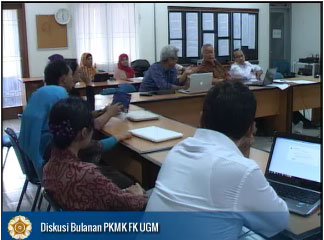

Session Tittle:
Health Insurance Market in Developing Countries
Sesi : Asuransi di Pasar Negara Berkembang
Dalam sesi ini terdapat empat paper yang akan dipresentasikan, tetapi karena adanya kendala teknis, hanya 2 paper yang dipresentasikan, yaitu:
 SESI 1: Apakah skema Asuransi mikro kesehatan dan asuransi kesehatan nasional bersama-sama bergabung untuk mencakupi sektor informal dan bergerak menuju cakupan kesehatan universal (Universal Health Coverage)?
SESI 1: Apakah skema Asuransi mikro kesehatan dan asuransi kesehatan nasional bersama-sama bergabung untuk mencakupi sektor informal dan bergerak menuju cakupan kesehatan universal (Universal Health Coverage)?
Oleh: Christina Synowiec (Results for Development Institute)
Paper ini menjelaskan tentang mikroinsurance dan hubungannya dengan universal health coverage. Dilatarbelakangi oleh kenyataan bahwa cakupan kesehatan universal (UHC), atau "suatu sistem di mana setiap orang dalam masyarakat dapat mendapatkan layanan perawatan kesehatan yang mereka butuhkan tanpa kesulitan keuangan," adalah bangunan di seluruh dunia, namun negara-negara menghadapi tantangan besar dalam memperluas cakupan ke sektor informal sektor. Sementara itu, asuransi mikro kesehatan (Health Mikro Insurance/HMI) yang sering dipimpin oleh badan swasta , telah berkembang secara bersamaan di tempat-tempat yang sama. Tapi itu belum mencapai skala, dan mengalami banyak hambatan, seperti menawarkan manfaat yang komprehensif, lintas-subsidi keberlanjutan keuangan yang sangat miskin dan jangkauannya. Kedua UHC dan asuransi mikro yang berjuang dengan cara yang berbeda, sayangnya, di sebagian besar negara mereka sebagian besar melanjutkan secara paralel, dengan berbagai kelompok pelaksana dan pendukung, meskipun memiliki tujuan yang sama.
Paper ini bermula dari hipotesis ada potensi kerja sama antara pemerintah dan microinsurers yang dapat membantu mengatasi masalah yang dihadapi oleh para pembuat kebijakan nasional dan HMIs. Dibutuhkan pemahaman hubungan antara HMI dan UHC dengan mengembangkan kerangka kerja untuk bagaimana dua gerakan bisa maju bersama, mengidentifikasi dan mendokumentasikan contoh nyata yang menggambarkan hubungan ini, dan menganalisis kasus-kasus ini untuk mengekstrak pelajaran penting dan wawasan.
Temuan tulisan ini menunjukkan bahwa ada enam peran yang menggambarkan hubungan HMI untuk UHC: pengganti, demonstrasi, yayasan, kemitraan, tambahan, dan duplikatif, dengan peran yang diinginkan HMI bergeser dari waktu ke waktu. Tulisan ini akan membahas empat peran peran komplementer HMI melalui pengalaman 8 negara yang berbeda (Kamboja, Ghana, India, Yordania, Kenya, Filipina, Tanzania, dan Thailand). Dari contoh terkenal scalling up CBHI di Ghana, untuk bermitra dengan HMI di Kenya dan Filipina, untuk menguji kebijakan-kebijakan baru dan model operasional di India dan Kamboja, untuk inovasi organik di Tanzania.
Paper ini juga berbagi checklist bagi para pembuat kebijakan yang bergulat dengan tantangan meliputi sektor informal. Banyak pemerintah memulai gerakan mereka menuju UHC dengan terlebih dahulu meliputi sektor formal, kemudian menargetkan masyarakat miskin melalui subsidi, tetapi mereka yang tetap berada di tengah cenderung datang terakhir dan yang paling menantang bagi banyak negara miskin dan berkembang untuk mencakupi semua. Bahkan jika pemerintah tidak memiliki kapasitas untuk mencakupi ekonomi informal segera, penting bagi para pembuat kebijakan untuk mempertimbangkan di mana mereka berada di sepanjang perjalanan menuju UHC dan apakah HMI dapat membantu untuk mencapai tujuan mereka. Sebuah strategi nasional perlu secara eksplisit mengakui dan mengartikulasikan peran HMI dan pembuat kebijakan dapat belajar dari pengalaman negara lain.
Demikian juga Indonesia visi untuk mencapai Universal health coverage, bukanlah hal yang mudah. Pemerintah dapat bermitra dengan HMI untuk mencakupi sektor sektor informal yang tidak mudah di jangkau oleh pemerintah. Pemerintah dapat mempertimbangkan HMI sebagai sumber daya untuk inovasi dan pembelajaran, dan melanjutkan kemitraan dengan entitas yang dapat membawa ide-ide, keuntungan, efisiensi, dan pengalaman.
 SESI 2: Implikasi dari perubahan bentuk imigrasi untuk mencakup asuransi kesehatan anak?
SESI 2: Implikasi dari perubahan bentuk imigrasi untuk mencakup asuransi kesehatan anak?
Paula Song (Ohio State University. Health Services Management and Policy)
Paper ini mencoba melihat cakupan asuransi kesehatan untuk anak dari keluarga imigran di Amerika Serikat. Dilatarbelakangi oleh tujuan penelitian kebijakan kesehatan AS yang sangat memeprtimbangkan cakupan asuransi kesehatan untuk anak-anak, meskipun kesenjangan yang signifikan dalam cakupan ada di antara anak-anak dalam keluarga imigran. Meskipun ACA memperluas cakupan asuransi kesehatan untuk orang dewasa dan anak-anak, tetapi gagal untuk mengatasi asuransi untuk imigran. Semakin kompleks, dalam kebijakan kesehatan imigran adalah ketika komposisi campuran keluarga imigran, di mana anak-anak sering memiliki kewarganegaraan AS, sementara orang tua mereka tidak. Makalah ini membahas peran imigrasi dalam menutupi kesenjangan cakupan untuk anak-anak. Secara khusus, makalah ini bertujuan untuk:
- mengidentifikasi pangsa anak yang tidak diasuransikan yang tinggal di keluarga imigran,
- menunjukkan peran kewarganegaraan anak dalam memperoleh cakupan, dan
- menggunakan teknik dekomposisi untuk mengidentifikasi pengurangan batas atas di tingkat asuransi anak jika anak-anak ini mendapatkan kewarganegaraan melalui tindakan legislatif.
Studi desain yang dipergunakan model probit status asuransi menggunakan data dari 2008-2011 Survei Masyarakat Amerika (ACS). ACS merupakan sampel yang representatif dari semua anak di bawah usia 18. Ini mencakup 2,5 juta anak 2008-2011, termasuk lebih dari 600.000 anak-anak dengan orang tua imigran. Karena data Sensus Amerika Serikat tidak mengumpulkan informasi tentang status imigrasi (yaitu, hukum residensi), pendekatan dekomposisi Fairlie digunakan untuk mengungkapkan potensi penurunan tingkat diasuransikan untuk anak-anak dari memperluas kewarganegaraan kepada anak-anak yang tidak memiliki dokumen.
Hasilnya menunjukkan bahwa memiliki orangtua imigran merupakan ciri khas anak-anak yang tidak diasuransikan. Sementara anak-anak dalam keluarga imigran hanya 24,1% dari semua anak di Amerika Serikat, mereka terdiri hampir setengah (42%) dari semua anak yang tidak diasuransikan di Amerika Serikat. Anak-anak ini hidup dalam keluarga imigran dan memiliki setidaknya satu orangtua imigran, tetapi 69% dari anak-anak imigran yang tidak diasuransikan sudah memegang kewarganegaraan AS. Analisis dekomposisi menunjukkan bahwa kewarganegaraan orangtua menjelaskan perbedaan terbesar dalam tingkat yang tidak diasuransikan untuk anak-anak.
Anak-anak dengan orang tua imigran hampir setengah dari semua anak yang tidak diasuransikan di Amerika Serikat. Tingginya persentase anak-anak yang tidak diasuransikan di keluarga imigran bukan karena status imigrasi anak sejak 2/3 sudah warga AS. Jika imigran kewarganegaraan mendapatkan anak, sebagian besar anak-anak akan tetap diasuransikan kecuali status imigrasi orang tua mereka juga berubah. Jadi, sementara status imigrasi anak menentukan kelayakan mereka untuk Medicaid dan manfaat publik lainnya, orang tua harus bersedia untuk mendaftarkan anak.
Makalah ini menunjukkan bahwa reformasi imigrasi yang hanya memperpanjang kewarganegaraan kepada anak-anak akan memiliki manfaat sedikit dalam mengurangi jumlah anak yang tidak diasuransikan di Amerika Serikat. Anak-anak dalam keluarga imigran akan tetap proporsional tidak diasuransikan jika reformasi imigrasi tidak mencakup orang tua mereka dewasa.
Kasus asuransi untuk keluarga imigran tidak banyak muncul di Indonesia karena sedikit adanya imigran dari luar negeri yang memasuki Indonesia baik secara legal maupun illegal. Namun demikian metode penelitan dapat diterapkan untuk menelusuri pemanfaatan asuransi kesehatan pada kelompok marginal tertentu seperti kelompok masyarakat yang melakukan urbanisasi ke kota (seperti Jakarta) dan tidak memiliki identitas lengkap, maupun tidak teregristrasi di Jakarta, sehingga program-program pemerintah Jakarta seperti kartu sehat tidak dapat mencakup kebutuhan akan kesehatan dari kelompok ini.










 Pengantar
Pengantar Kegiatan Semiloka hari ini adalah:
Kegiatan Semiloka hari ini adalah: Tujuan Pertemuan:
Tujuan Pertemuan: Jadwal Acara dan Topik
Jadwal Acara dan Topik

 Arsip Video Presentasi
Arsip Video Presentasi